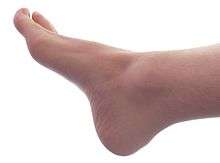पाँव
Hindi

पाँव
Alternative forms
- पांव (pā̃v)
Etymology
From Sauraseni Prakrit 𑀧𑀸𑀅 (pāa), from Sanskrit पाद (pā́da) / पद् (pád, “foot”), from Proto-Indo-Aryan *pā́ts, from Proto-Indo-Iranian *pā́ts, and from Proto-Indo-European *pṓds. compare Persian پا (pâ), Hittite [Term?] (/pata/), Latin pēs, pedis, Tocharian A pe, Tocharian B paiyye, Lithuanian pāda (“sole (foot)”), Russian под (pod, “ground”), Ancient Greek πούς, ποδός (poús, podós), Old Armenian ոտն (otn), English foot.
Pronunciation
- IPA(key): /pɑ̃ːʋ/, [pɑ̃ːʊ]
Noun
पाँव • (pā̃v) m (Urdu spelling پاؤں)
This article is issued from
Wiktionary.
The text is licensed under Creative
Commons - Attribution - Sharealike.
Additional terms may apply for the media files.